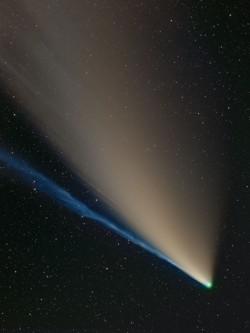Glossary term: Cometary Coma
Description: As a comet approaches the Sun, part of the solid substances bound in the comet's icy nucleus turn into gas. This gas, which mostly consists of water but will also contain other chemicals such as carbon monoxide, carbon dioxide, ammonia, methane, and methanol, as well as dust particles, surrounds the nucleus like a fuzzy, spherical cloud, which is called the cometary atmosphere, or coma. As the comet gets closer to the Sun, more and more molecules get split up by the Sun's ultraviolet photons, heating the coma and making its outer regions expand. Eventually, the outer regions get ionized, forming the comet's ion tail.
Related Terms:
See this term in other languages
Term and definition status: This term and its definition have been approved by a research astronomer and a teacher
The OAE Multilingual Glossary is a project of the IAU Office of Astronomy for Education (OAE) in collaboration with the IAU Office of Astronomy Outreach (OAO). The terms and definitions were chosen, written and reviewed by a collective effort from the OAE, the OAE Centers and Nodes, the OAE National Astronomy Education Coordinators (NAECs) and other volunteers. You can find a full list of credits here. All glossary terms and their definitions are released under a Creative Commons CC BY-4.0 license and should be credited to "IAU OAE".
Related Media
Comet C/2020F3 (Neowise) with separate dust and ion gas tails and a green glowing coma, by Dietmar Gutermuth, Germany
Credit: Dietmar Gutermuth/IAU OAE
License: CC-BY-4.0 Creative Commons Attribution 4.0 International (CC BY 4.0) icons









